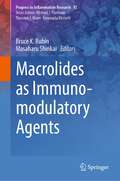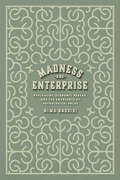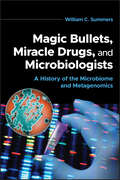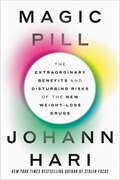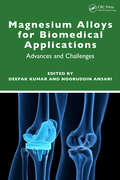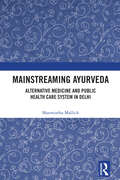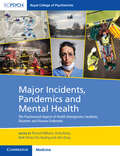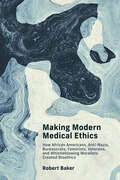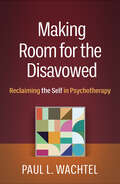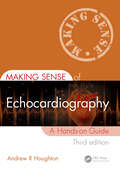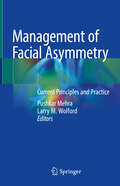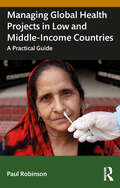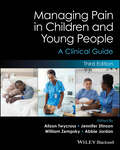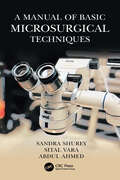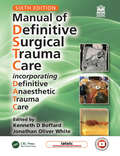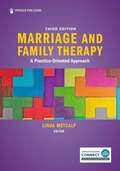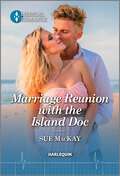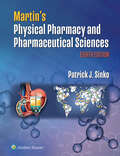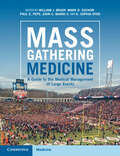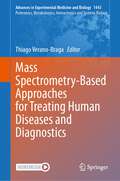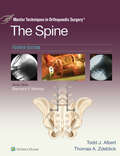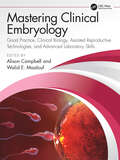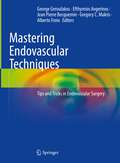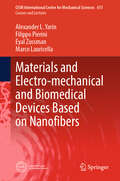- Table View
- List View
Macrolides as Immunomodulatory Agents (Progress in Inflammation Research #92)
by Bruce K. Rubin Masaharu ShinkaiFor over 50 years, clinicians have known that macrolide antibiotics have effects on inflammation and the immune system that are not related to their antimicrobial properties. These immunomodulatory properties, best described for treating inflammatory airway diseases, protect the lung and the host and improve clinical status. This book summarizes our current knowledge regarding proposed mechanisms for these properties, established clinical results, and what the future may hold with emphasis on novel clinical applications and the fascinating development of non-antimicrobial macrolides with preserved and enhanced immunomodulatory properties.
Madness and Enterprise: Psychiatry, Economic Reason, and the Emergence of Pathological Value
by Nima BassiriUncovers a powerful relationship between pathology and money: beginning in the nineteenth century, the severity of mental illness was measured against a patient’s economic productivity. Madness and Enterprise reveals the economic norms embedded within psychiatric thinking about mental illness in the North Atlantic world. Over the course of the nineteenth century, various forms of madness were subjected to a style of psychiatric reasoning that was preoccupied with money. Psychiatrists across Western Europe and the United States attributed financial and even moral value to an array of pathological conditions, such that some mental disorders were seen as financial assets and others as economic liabilities. By turning to economic conduct and asking whether potential patients appeared capable of managing their financial affairs or even generating wealth, psychiatrists could often bypass diagnostic uncertainties about a person’s mental state. Through an exploration of the intertwined histories of psychiatry and economic thought, Nima Bassiri shows how this relationship transformed the very idea of value in the modern North Atlantic, as the most common forms of social valuation—moral value, medical value, and economic value—were rendered equivalent and interchangeable. If what was good and what was healthy were increasingly conflated with what was remunerative (and vice versa), then a conceptual space opened through which madness itself could be converted into an economic form and subsequently redeemed—and even revered.
Magic Bullets, Miracle Drugs, and Microbiologists: A History of the Microbiome and Metagenomics
by William C. SummersMagic Bullets, Miracle Drugs, and Microbiologists Magic Bullets, Miracle Drugs, and Microbiologists: A History of the Microbiome and Metagenomics by William C. Summers is an enlightening journey through the fascinating world of microbiology, exploring its history, challenges, and the revolutionary concept of the microbiome. Summers draws from his unique perspective as both a practicing microbiologist and a historian of science, influenced by early microbiological literature and his own extensive career, presenting how our understanding of microbes evolved from concepts of simple germs to complex, essential elements of life. Summers skillfully ties together key players and eras in the microbial sciences into a concise narrative, from early microscopic observations to the revolutionary developments in genetic analysis and metagenomics, highlighting our ever-evolving understanding of the diverse microbial world. Magic Bullets, Miracle Drugs, and Microbiologists is a compelling read for anyone interested in the profound impact of microorganisms on our world. “Bill Summers artfully explains how, over the past century, scientists have synthesized new disciplines and embraced evolving technologies to develop new concepts about how germs behave in microbial communities and what their relationship is to the environment, human health, and epidemic diseases. Skillfully written in engaging prose, this book will be valuable to microbiologists, epidemiologists, medical historians, and geneticists seeking to better understand the historic roots of twenty-first century microbiology.” — Powel H Kazanjian, University of Michigan Medical School and Author of Frederick Novy and the Development of Bacteriology in Medicine
Magic Pill: The Extraordinary Benefits and Disturbing Risks of the New Weight-Loss Drugs
by Johann HariThe bestselling author of Lost Connections and Stolen Focus offers a revelatory look at the new drugs transforming weight loss as we know it—from his personal experience on Ozempic to our ability to heal our society&’s dysfunctional relationship with food, weight, and our bodies.In January 2023, Johann Hari started to inject himself once a week with Ozempic, one of the new drugs that produces significant weight loss. He wasn&’t alone—some predictions suggest that in a few years, a quarter of the U.S. population will be taking these drugs. While around 80 percent of diets fail, someone taking one of the new drugs will lose up to a quarter of their body weight in six months. To the drugs&’ defenders, here is a moment of liberation from a condition that massively increases your chances of diabetes, cancer, and an early death. Still, Hari was wildly conflicted. Can these drugs really be as good as they sound? Are they a magic solution—or a magic trick? Finding the answer to this high-stakes question led him on a journey from Iceland to Minneapolis to Tokyo, and to interview the leading experts in the world on these questions. He found that along with the drug&’s massive benefits come twelve significant potential risks. He also found that these drugs radically challenge what we think we know about shame, willpower, and healing. What do they reveal about the nature of obesity itself? What psychological issues begin to emerge when our eating patterns are suddenly disrupted? Are the drugs a liberation or a further symptom of our deeply dysfunctional relationship with food? These drugs are about to change our world, for better and for worse. Everybody needs to understand how they work—scientifically, emotionally, and culturally. Magic Pill is an essential guide to the revolution that has already begun, and which one leading expert argues will be as transformative as the invention of the smartphone.
Magnesium Alloys for Biomedical Applications: Advances and Challenges
by Deepak Kumar Nooruddin AnsariMagnesium alloys have enormous potential for use in biomedical implants. Magnesium Alloys for Biomedical Applications delves into recent advances and prospects for implementation and provides scientific insights into current issues posed by Mg alloy materials. It provides an overview of research on their mechanical and tribological characteristics, corrosion tendencies, and biological characteristics, with a particular emphasis on biomedical implants. Details the fundamentals of Mg alloys as well as necessary surface modifications of Mg alloys for biomedical use. Discusses emerging Mg alloys and their composites. Covers mechanical, tribological, and chemical properties, as well as fatigue and corrosion. Highlights emerging manufacturing methods and advancements in new alloy design, composite manufacturing, unique structure design, surface modification, and recyclability. Helps readers identify appropriate Mg-based materials for their applications and select optimal improvement methods. Summarizes current challenges and suggests a roadmap for future research. Aimed at researchers in materials and biomedical engineering, this book explores the many breakthroughs achieved with these materials and where the field should concentrate to ensure the development of safe and reliable Mg alloy-based implants.
Mainstreaming Ayurveda: Alternative Medicine and Public Health Care System in Delhi
by Sharmistha MallickThis book brings concepts, practices of Ayurveda and its interface with modern health care set-up in Delhi, India. It presents a new conceptual framework in studying public health in India, offers policy recommendations and outlines the challenges of mainstreaming of alternative medical systems in India.Drawing on a wealth of primary data that looks at the social profile of patients, gender, disease profile of patients, prescriptions, average cost per prescription and kinds of medicines prescribed, the monograph explores patterns of health behaviour through the perceptions of doctors and patients, administrators and their negotiations with the bureaucratic health structure. It analyses the power and structures between practitioners of modern medicine and Ayurvedic doctors and the issues of cross referral and formal and informal levels of interaction/network between the two medical systems. Engaging with current debates around public health in India, the volume will be of interest to scholars and researchers of public health and sociology of health and medicine, public policy and public administration and South Asian studies.
Major Incidents, Pandemics and Mental Health: The Psychosocial Aspects Of Health Emergencies, Incidents, Disasters And Disease Outbreaks
by Richard Williams Verity Kemp Keith Porter Tim Healing John DruryMaking Modern Medical Ethics: How African Americans, Anti-Nazis, Bureaucrats, Feminists, Veterans, and Whistleblowing Moralists Created Bioethics (Basic Bioethics)
by Robert BakerThe little-known stories of the people responsible for what we know today as modern medical ethics.In Making Modern Medical Ethics, Robert Baker tells the counter history of the birth of bioethics, bringing to the fore the stories of the dissenters and whistleblowers who challenged the establishment. Drawing on his earlier work on moral revolutions and the history of medical ethics, Robert Baker traces the history of modern medical ethics and its bioethical turn to the moral insurrections incited by the many unsung dissenters and whistleblowers: African American civil rights leaders, Jewish Americans harboring Holocaust memories, feminists, women, and Anglo-American physicians and healthcare professionals who were veterans of the World Wars, the Cold War, and the Vietnam War.The standard narrative for bioethics typically emphasizes the morally disruptive medical technologies of the latter part of the twentieth century, such as the dialysis machine, the electroencephalograph, and the ventilator, as they created the need to reconsider traditional notions of medical ethics. Baker, however, tells a fresh narrative, one that has historically been neglected (e.g., the story of the medical veterans who founded an international medical organization to rescue medicine and biomedical research from the scandal of Nazi medicine), and also reveals the penalties that moral change agents paid (e.g., the stubborn bureaucrat who was demoted for her insistence on requiring and enforcing research subjects&’ informed consent). Analyzing major statements of modern medical ethics from the 1946–1947 Nuremberg Doctors Trials and Nuremberg Code to A Patient&’s Bill of Rights, Making Modern Medical Ethics is a winning history of just how respect and autonomy for patients and research subjects came to be codified.
Making Room for the Disavowed: Reclaiming the Self in Psychotherapy
by Paul L. WachtelIn this uniquely integrative book, Paul L. Wachtel describes powerful clinical strategies to make room for aspects of the self that were sidetracked in the course of development. Wachtel explores how early attachment experiences can lead people to turn away from certain thoughts and feelings, building a sense of self and ways of interacting on only a limited range of adaptive resources. His approach draws on psychodynamic, humanistic, systemic, and acceptance-centered cognitive-behavioral perspectives, as well as attention to the impact of race, class, and culture. Filled with rich case material, the book illuminates how a therapeutic approach anchored in the present can help heal the wounds of the past.
Making Sense of Echocardiography: A Hands-on Guide (Making Sense of)
by Andrew R. HoughtonEchocardiography is one of the most useful and powerful diagnostic tools in the assessment of cardiac structure and function. It remains a rapidly expanding modality, with new techniques constantly developing and maturing. Building on the success of the second edition, the third edition of Making Sense of Echocardiography: A Hands-on Guide provides a timely overview for those learning echocardiography for the first time as well as an accessible handbook that experienced sonographers can refer to. The strong clinical focus and concentration on real-life scenarios make this book relevant in day-to-day practice. Key updates for this edition include the latest guidelines for the evaluation of diastolic function and pulmonary hypertension, and fully updated reference intervals throughout. Key Features:• Covers not only the fundamentals of echocardiography including ultrasound physics, but also covers new technologies such as 3D echocardiography.• Provides a comprehensive approach for the echo trainee and also serves as a useful reference for more seasoned echocardiographers.• Incorporates current guidelines and reference intervals throughout.
Management of Facial Asymmetry: Current Principles and Practice
by Pushkar Mehra Larry M. WolfordThis book provides clear practical guidance on the contemporary management of patients with asymmetry of facial structures. Patient evaluation and diagnosis are first fully described. Key radiological and orthodontic considerations are identified and the role of virtual surgical planning is explained. Individual chapters then focus on management principles in patients with craniosynostosis, hemifacial microsomia, condylar hyperactivity, and temporomandibular ankylosis/degenerative disease. The remainder of the book is devoted to the state of the art in treatment procedures, covering distraction osteogenesis, the use of facial implants, diverse soft tissue procedures, and jaw and other osteotomies. The text is augmented by informative clinical cases, easy-to-follow tables, photographs, and illustrations. The authors are highly experienced clinicians well recognized for their expertise in this area. The book will be ideal for all clinicians involved in the care of patients afflicted by facial asymmetry and will in particular be an indispensable tool for those who evaluate and treat the condition in day-to-day practice.
Managing Global Health Projects in Low and Middle-Income Countries: A Practical Guide
by Paul RobinsonWith over 30 years of experience in global health programming and teaching, the author offers practical and insightful guidance in this unique book for managing global health projects in resource-constrained settings.Beginning with an overview of fundamental principles, the book delves deeply into a ‘nuts and bolts’ approach to health project management. From building project teams and developing detailed activity plans to evaluating health projects and report writing, this book brings the readers a wealth of knowledge they can use to manage health projects. Besides a list of key takeaways and discussion questions, each chapter features a case study exercise from real life situation where readers can picture themselves as project managers, sharpening their understanding of concepts and strategies.Timely and original, this book is an essential resource for university students of global health courses preparing to manage global health projects in low- and middle-income countries, as well as for newly engaged project managers.
Managing Pain in Children and Young People: A Clinical Guide
by Alison Twycross Jennifer Stinson William T. Zempsky Abbie JordanMaster paediatric pain management with precision This practical guide equips nurses and healthcare professionals with evidence-based skills to effectively manage children's pain. Explore assessment techniques, pain relief strategies, and best practices for both hospital and community settings, with a focus on core knowledge, advanced insights, clinical scenarios, and practical tips. The fully updated third edition includes an expanded procedural sedation section, enhanced coverage of capnography for respiratory monitoring, a new quality improvement sciences section, and additional online MCQs and self-assessment material. Written by experienced authors, with contributions from global experts, Managing Pain in Children and Young People covers: Why pain prevention and treatment are crucial Pain's biopsychosocial nature and pharmacology of analgesic drugs Acute nociceptive, neuropathic, and visceral pain management Chronic headaches, post-surgical pain, neonatal pain, and procedural pain Paediatric palliative care and pain management in low-income countries Drug-free pain relief methods and ethical considerations With a multidisciplinary focus, this essential resource is tailored for healthcare practitioners working with children and young people; including doctors, nurses, psychologists, and physiotherapists. This essential resource empowers you to provide the best possible care for young patients, helping them find comfort and relief in their journey towards healing.
A Manual of Basic Microsurgical Techniques
by Sandra Shurey Sital Vara Abdul AhmedA practical surgical manual providing a step-by-step guide to basic microsurgical techniques for the reconstruction of small vessels, nerves, and vas deferens. This also includes access to videos demonstrating core microsurgical techniques. Incorporating 40 years of experience gained by the teachers of the microvascular course at Northwick Park, the techniques described in this manual have trained generations of surgeons. Fully illustrated and with a clear, succinct text, this manual will enable the reader to master basic skills quickly and confidently. Microsurgery is not difficult, provided it is taught properly: There is no magic formula, but it must be learnt slowly, patiently and step by step. This valuable resource will be useful for surgeons in training and in practice and for research workers who are increasingly using microsurgical techniques in their experiments.
Manual of Definitive Surgical Trauma Care: Incorporating Definitive Anaesthetic Trauma Care
by Kenneth D Boffard Jonathan Oliver WhiteDeveloped for the International Association for Trauma Surgery and Intensive Care (IATSIC), the Manual of Definitive Surgical Trauma Care 6e is ideal for training all surgeons and anaesthetists who manage trauma on an infrequent basis.The Manual is updated every 4 years and reflects the most recent developments in patient management based on new evidence-based information. Its focus is on the importance of the multidisciplinary care of the trauma surgical patient. This sixth edition has evolved, and the all-important section on the Non-Technical Skills which are required has been expanded. A significant number of the original guidelines in trauma have been archived, as they are no longer pertinent or have been superseded. The increasing (and occasionally harmful) role of non-operative management (NOM) has been recognized. The ‘Military Environments’ and ‘Austere Environments’ chapters have been substantially revised to reflect current multinational combat experience, and broadened to reflect modern asymmetrical conflicts and the increased need for humanitarian intervention including military peacekeeping in which only one side wears a uniform. Military weapons are used in major cities against the civilian population. More recently, urban, non-military populations have been the targets and victims of heavy military combat including use of ultra-sophisticated weaponry. Each situation carries its own spectrum of injury and responsibility of care.Including website access to a selection of videos which provide an anatomic overview of surgical approaches, this resource provides a gold standard educational and training resource to help prepare the relatively fully trained surgeon to manage the difficult injuries that might present to a major trauma centre.
Marriage And Family Therapy: A Practice-oriented Approach
by Linda MetcalfLearn how to take different models of therapy from theory to real world practice Delivering proven therapeutic strategies that can be used immediately by students of marital and family therapy, this text brings 15 modern and postmodern therapy models to life through guiding templates and interviews with master therapists. The text progresses step-by-step through marriage and family essentials, describing in detail the systemic mindset and basic terminology used by the marriage and family therapist. Interviews with such master therapists as Albert Ellis, David V. Keith, and Mariana Martinez―who each provide commentary on a single case study―give readers the opportunity to observe different models in action, clarifying theory and practice simultaneously. Instructive templates for each model illuminate the nuts and bolts of the therapy process and help instructors bring content to life, so students can visualize and practice the process. The updated third edition presents new interviews with master therapists, a new case study that reflects the modern-day client, and a section on social justice in each chapter. Also featured in the third edition are links to valuable new websites, recommended reading for in-depth study of each model, and an updated Instructor Manual, Test Bank, and Instructor Chapter PowerPoints. Audio and Video content are also available for chapters focusing on therapy models to dive deeper into practical application, interviews, and role play. Purchase includes online access via most mobile devices or computers. New to the Third Edition: New chapters on social justice, teletherapy practices, marriage and family therapy in times of crisis including COVID-19, and the advantages of an accredited program New interviews with master therapists who are evolving the systemic mindset, including an updated case study that reflects the contemporary client A section on social justice for each therapy model Audio and video content with interviews, discussions, and role play to enhance learning Key Features: Provides a guiding template for each model from assessment through termination Introduces the theory, history, theoretical assumptions, techniques, and components of each paradigm Delivers numerous interviews, case study commentaries, and analyses by prominent master therapists Provides theory and practice on supervision, research, ethics, and self-care of the therapist
Marriage Reunion with the Island Doc
by Sue MacKayBeing stuck at a destination wedding with her ex-husband isn&’t the holiday she had planned! Find out if this could be their second chance in the latest Harlequin Medical Romance from Sue MacKay. A SECOND CHANCE IN PARADISE? At a destination wedding, nurse Alyssa is hoping for a stress-free break. But the best man is her ex-husband, island GP Leighton! Their whirlwind marriage collapsed as quickly as it began when Leighton suddenly withdrew from her. Alyssa never understood why, and now that they&’re stuck together for a fortnight, she wants to find out! Will her dream holiday end in closure…or a romantic reunion?From Harlequin Medical: Life and love in the world of modern medicine.
Martin's Physical Pharmacy and Pharmaceutical Sciences
by Patrick J. SinkoConsistently revised and updated for more than 60 years to reflect the most current research and practice, Martin’s Physical Pharmacy and Pharmaceutical Sciences, 8th Edition, is the original and most comprehensive text available on the physical, chemical, and biological principles that underlie pharmacology and the pharmaceutical sciences. An ideal resource for PharmD and pharmacy students worldwide, teachers, researchers, or industrial pharmaceutical scientists, this 8th Edition has been thoroughly revised, enhanced, and reorganized to provide readers with a clear, consistent learning experience that puts essential principles and concepts in a practical, approachable context. Updated content reflects the latest developments and perspectives across the full spectrum of physical pharmacy and a new full-color design makes it easier than ever to discover, distinguish, and understand information—providing users the most robust support available for applying the elements of biology, physics, and chemistry in work or study.
Mass Gathering Medicine: A Guide to the Medical Management of Large Events
by William J. Brady Mark R. Sochor Paul E. Pepe John C. Maino II K. Sophia DyerMass medical deployments to large events, such as music festivals or sporting events, are increasing in number, size, and complexity. This textbook provides guidance and direction for rational, effective, and practical medical management of mass gathering events for medical leaders. This is the first authoritative text on mass event medicine, filling a much-needed gap in a large and important area of the specialty. An international group of contributors introduce the specialty and cover topics such as general deployment, staffing, equipment, and resources, moving on to more complex issues such as the business aspect of mass gathering medicine and the legal implications. There are also practical chapters on specific types of events and adverse events such as terrorism, severe weather, and civil disobedience. An invaluable text for all healthcare professionals planning for and attending mass events, particularly EMS professionals, large event planners and administrators, and law enforcement and security personnel.
Mass Spectrometry-Based Approaches for Treating Human Diseases and Diagnostics (Advances in Experimental Medicine and Biology #1443)
by Thiago Verano-BragaThis book presents the technological advances in the field of mass spectrometry-based approaches for treating human diseases and diagnostics as well as the application of such approaches to study, in depth, human diseases, biomarkers discovery and validation, and to provide mechanistic insights of potential new therapeutics. This is an ideal book for students, technicians, researchers, and medical doctors that work in the field of mass spectrometry and proteomics
Master Techniques in Orthopaedic Surgery: The Spine (Master Techniques in Orthopaedic Surgery)
by Albert J. Todd Thomas A. ZdeblickPart of the highly regarded Master Techniques in Orthopaedic Surgery® series,The Spine, Fourth Edition, is a concise, lavishly illustrated reference covering the most advanced, successful surgical techniques for the spine—all in step-by-step detail. Edited by Drs. Todd J. Albert and Thomas A. Zdeblick, this fully revised edition presents the preferred techniques of surgical masters, illustrated with sequential, surgeon’s-eye view intraoperative photographs, as well as superb drawings by noted medical illustrators. New contributing authors and new and rewritten chapters keep you fully up to date with recent changes in the field.
Mastering Clinical Embryology: Good Practice, Clinical Biology, Assisted Reproductive Technologies, and Advanced Laboratory Skills
by Alison Campbell Walid E. MaaloufClinical scientists, embryologists, and reproductive technologists, at all levels, as well as trainees and students interested in assisted reproductive technology and reproductive medicine, will find here a clear synopsis of the best laboratory practice, clinical biology, assisted reproduction techniques, and advanced practical skills they will need to know as clinical practitioners. Expert embryologists and trainers contributed to the essential material as well as a number of advanced topics.Key features: Offers a clear synopsis of the clinical biology, laboratory skills, and best practice for the trainee embryologist Provides the ideal reference resource for those undertaking postgraduate training to become a clinical embryologist Gives access to the views of expert embryologist and trainers
Mastering Endovascular Techniques: Tips and Tricks in Endovascular Surgery
by George Geroulakos Efthymios Avgerinos Jean Pierre Becquemin Gregory C. Makris Alberto FroioThis book provides a detailed practically applicable guide to using the latest endovascular techniques. Chapters feature detailed step-by-step instructions on how to perform procedures relevant for instances of disorders including cerebrovascular disease, splachnic arteries, and aortic aneurysms. Multiple choice questions are provided throughout to enable the reader to identify the points covered. Mastering Endovascular Techniques: Tips and Tricks in Endovascular Surgery describes the latest endovascular methodologies and features detailed insight on how to apply these techniques into day-to-day clinical practice.
Materials and Electro-mechanical and Biomedical Devices Based on Nanofibers (CISM International Centre for Mechanical Sciences #611)
by Alexander L. Yarin Filippo Pierini Eyal Zussman Marco LauricellaThe book is interwoven according to the intrinsic logics of modern most important applications of electrospun nanofibers. It discusses such application-oriented nanofibers as self-healing vascular nanotextured materials, biopolymer nanofibers, soft robots and actuators based on nanofibers, biopolymer nanofiber-based triboelectric nanogenerators, metallized nanofibers, and heaters and sensors based on them. It also includes such topics as the injectable nanofibrous biomaterials, fibrous hemostatic agents and their interaction with blood, as well as electrospun nanofibers for face-mask applications. The book also details polyelectrolytes-based complex nanofibers and their use as actuators. It also covers drug release facilitated by polyelectrolytes-based complex nanofibers. The fundamental aspects of electrospinning of polymer nanofibers discussed in the final part of the book link them to the applications described in the preceding chapters. Such topics as polymer solution preparation and their rheological properties, e.g., viscoelasticity and the related spinnability, the electrical conductivity of polymer solutions, and the cascade of the physical phenomena resulting in formation of nanofibers encompass the experimental aspects. Also, the general quasi-1D equations used for modeling of formation of electrospun polymer nanofibers, and the numerical aspects of their solution are discussed in detail, including such modeling-driven applications as nanofiber alignment by electric focusing fields.
